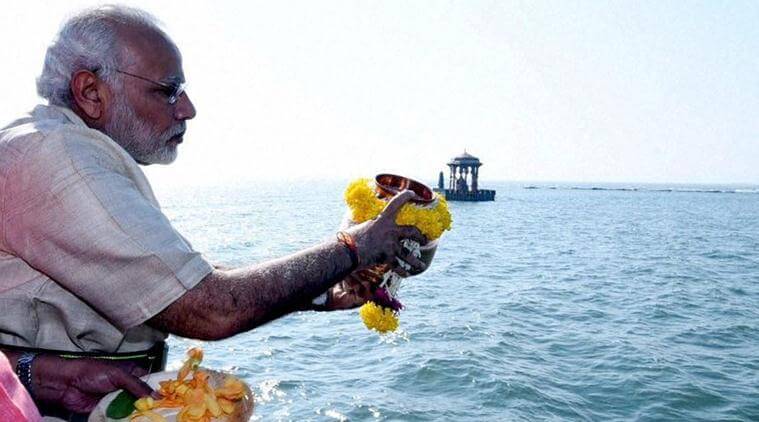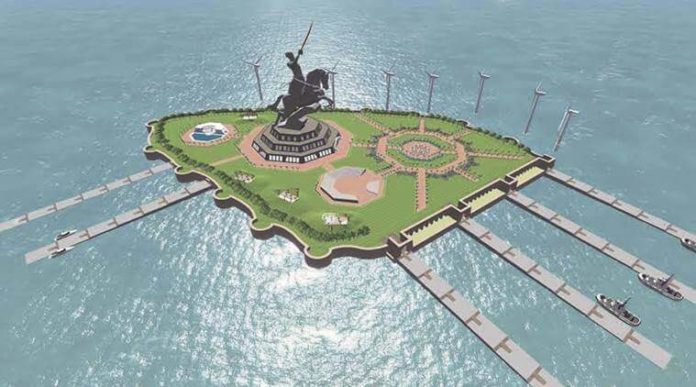Source of Inspiration & a Catalyst for Patriotism
Our cultural and civilizational icons need to be revered and celebrated. Places, memorials and statues of our national icons are not merely pieces of concrete but a reminder to recall their sacrifices and live the path they showed us. Some suggest that the government should rather invest in alleviating property than spend money on building statues. But this will not end up being a mere statue but a tourist hotspot, generating hundreds of crores for the state’s exchequer. It is therefore an investment in tourism too.
By Ganashyam
Maharashtra is excited about building a life-size statue of Maratha warrior Chhatrapati Shivaji. The construction work is expected to pick up in February, because 9th of February is the king’s birthday.
The 192-metre statue, expected to be completed by 2019, is estimated to cost Rs. 3600 crores. But the government is hopeful of recouping the money it is spending, as the statue will turn out to be one of the popular tourist hotspots.
Considering its master plan, this is going to be the tallest statues in the world, with analysts estimating it to grow twice the size of New York’s Statue of Liberty and five times taller than that of Christ the Redeemer in Brazil’s Rio de Janeiro.
To minimize the potential damage could be caused to the local environment, Maharshtra government will use the rubble generated from the construction of the underground Metro line between Colaba and Seepz.
The rock islet where the memorial is being built submerges during the high tide. To build the memorial and set up allied facilities, tonnes of sand would be needed. So instead of sand dredged from other parts, the PWD felt that it would be environmentally and economically sound to reuse the excavated sand from the Metro project.
Some of the arrangements for transportation of the rubble to the memorial site are already in place. Six months ago, the chief minister had permitted the MMRC to make use of a jetty near the Bandra end of the Bandra-Worli Sea Link. This could be used for the transportation of the muck in barrages to the memorial site. The agency is also in talks with JNPT authorities for allowing a similar operation for another jetty (Kerosene jetty) in Sewri.
Ram Sutar, the 92 year old acclaimed artist, will be the sculptor for this statue. The project management consultancy service is given to the Egis India, a part of a French construction group that provided consultancy service for building five flood-protection dams in Jeddah, Saudi Arabia. The Egis group is also looking after a container terminal at Jawaharlal Nehru Port Trust at Raigad. This group also looks after the maintenace of Eiffel Tower.
Apart from the statue, the project will also encompass an amphitheatre and auditorium with a capacity to hold between 500 and 2000 people. Also part of the project is an exhibition gallery.
There will be an art museum spread over in an area of 4000 sq. meter and a world class aquarium. The project will also house a library which will include literature about Shivaji’s life. You can view the statue from varying levels. It will also have helipads, jetties, sea wall and breakwaters.
Mammoth statues of this kind are popular tourist sites elsewhere in the world. Both the Statue of Liberty and the Jesus Christ statue in Brazil, for example, draw scores of travelers from around the world, generating millions of dollars for local governments.
Therefore, the government is optimistic that the area in and around the statue may be able to generate a lot of jobs once the statue is built. It will also bring in more tourists to other nearby tourist spots in Maharshtra.
Since this project was announced, many fishermen in the surrounding area have been protesting against the project. They said that the road constructed to the Shivaji memorial will take away their fishing areas and subsequently snatch their livelihood.
But this is not the case, as the Maharshtra government has clearly stated that there will be no roads built to the Shivaji Memorial. This means the visitors will have to get there by boat, which will in turn help boatmen earn livelihood by ferrying people between the statue and the coastline.
It is estimated that 5–6 million cubic meter of hard rock will be received from the tunnel activity and building stations. When this would be crushed, it will provide 10–12 million cubic meter of sand.
There will be two points from where visitors would take a boat to the Shivaji memorial. These points are Nariman point and Gateway of India. BMC will build multilevel car parks where the visitors can park their cars. This will generate revenue for the BMC, which can be used for productive work like good maintenance of the drainage system of the city.
In Indian context, Rs. 3600 crore project would be a huge cost even for the government. Many protestors are claiming that such huge cost could have been used to fund numerous developmental works, which the country badly needs. Going by that logic, various other entertainment options like cricket matches and malls in the country should be banned because they use too much electricity and cricket brings whole nation to a standstill for several hours. The electricity spent in day-and-night cricket matches and malls and other places of entertainment like cinema theatres could light up homes of millions of poor families for free.
Not everything can be measured in cost-profit ratio. Shivaji Memorial is definitely a pride of the nation, and being the tallest statue in the world, it will bring in lots of visitors and create earning opportunities for the people around the area.
Box Item
The Monetary Aspect
The project includes not just the statue of a historical ruler but it also includes other facilities such as an amphitheatre.
Once the statue is complete, and open to the public, Rs 100 is incurred to reach the island by boat, and Rs 50 spent on entry fee, and, if on an average a 1,000 people visit in a day, it would yield nearly Rs 5.5 crore a year.
While this is a small figure, it merely gives us a glimpse of the revenue potential. Further, with an amphitheatre also being proposed, more revenue can be netted by renting out the premises to major events and even performances.
The Maharashtra Tourism Development Corporation (MTDC) currently acts as an aggregator for ferries and catamarans connecting the Gateway of India to Gharapuri Island, where the Elephanta Caves are located with a fare of Rs 160 for a return trip. The same model can be applied for the Shiv Smarak, thereby giving the water transport industry a boost.
Mumbai’s much talked about Water Transport programme, has not taken off, despite a massive push from Nitin Gadkari for shipping, inland waterways and ship-building.
While many have argued that the money can be “better spent” on social welfare, or education, feeding people, or irrigation, what one must remember is that the government spending is never a zero-sum game. When the government spends on a statue of Shivaji as an investment in tourism, it doesn’t mean there is a compromise on other important sectors.

(Shivaji Memorial will be the tallest statue in the world)

(Work has already begun for the statue with the PM inaugurating the work)












